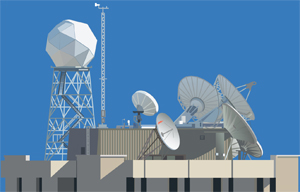Thirty Years of Cloud Studies Paying Off
Floating past in a constant parade overhead, clouds are easily taken for granted. From wispy high altitude cirrus clouds to the darkly threatening wall of an approaching storm, they are familiar parts of our everyday lives. But at a time when the state of our atmosphere, its components, its stability or lack of same, is rapidly becoming one of the most important questions facing us, the need to understand the complex dynamics of our cloud-filled atmosphere is at an all-time high.
An article published in the Bulletin of the American Meteorological Society, “Assessment of Global Cloud Datasets from Satellites: Project and Database Initiated by the GEWEX (Global Energy and Water Exchanges Radiation Panel) Cloud Assessment,” compares and evaluates current long-term cloud data products from a variety of sensors and research teams.
Of the many cloud datasets measured by the GEWEX study, four originated at the UW-Madison Space Science and Engineering Center (SSEC) and the Cooperative Institute for Meteorological Satellite Studies (CIMSS):
- High-Resolution Infrared Radiation Sounder (HIRS)
- Advanced Very High Resolution Radiometer (AVHRR) Pathfinder Atmospheres – Extended, (PATMOS-X)
- Advanced Very High Resolution Radiometer Polar Pathfinder (APP)
- MODerate-resolution Imaging Spectroradiometer (MODIS)
Three of those are featured in the chart below:
Seasonal cycle (relative) of cloud amount (CA) for four latitude bands: NH midlatitudes (30°–60°N),
NH tropics (0°–30°N), SH tropics (0°–30°S), and SH midlatitudes (30°–60°S). Statistics are averaged
over daytime measurements. Note that the important data captured is the change
in cloud amount
from place to place and time to time, and not the averages.
Image credit: Stubenrauch, et al., BAMS, Vol. 94, Issue 7 (July 2013).
The High-Resolution Infrared Radiation Sounder (HIRS) is an operational atmospheric sounding instrument that has been carried on the NOAA polar orbiting satellite series since 1978. Paul Menzel, Senior Scientist at SSEC, has been involved with the HIRS project since the beginning.
“HIRS is the only instrument that offers a spectral coverage record for more than 30 years,” Menzel says. “It can look at the stratosphere and the troposphere for temperature, moisture, and clouds. Currently, we are recalibrating all of those records so we can standardize the sensors, using a reference sensor to unify the data. That’s a lot of work, but that dataset will be precious.”
Another dataset is the Advanced Very High Resolution Radiometer (AVHRR) Pathfinder Atmospheres – Extended, (PATMOS-X) a project to derive atmospheric and surface climate records from the data collected by the AVHRR instruments flown on polar-orbiting satellites. The first global AVHRR data set, it was originally developed by Andrew Heidinger and Mike Pavolonis, NOAA physical scientists stationed at CIMSS. Andi Walther, Denis Botambekov, and Mike Foster, also of CIMSS, are adding new refinements to the data set. PATMOS-X consists of twice daily fields from all AVHRR data from 1981 to the present.
“We are turning the raw measurements of over thirty years into climate data records,” Heidinger says. “We work on the archives, but all of our satellites are still active, so the PATMOS-X AVHRR record still has new data coming in every day. This is easier now, with larger, faster computer processing capabilities. The original PATMOS project, which ended in 1999, cost a million dollars a year and was able to run through the data once. Now we are a $50,000 project and we do the same work in a month.
In addition to HIRS and PATMOS-X, the Advanced Very High Resolution Radiometer Polar Pathfinder (APP) project utilizes polar orbiting satellites to record twice-daily surface temperatures, albedos and other cloud data from both poles. Created by Xuanji Wang of CIMSS and Jeff Key, NOAA lead scientist at CIMSS, the APP dataset so far contains 30 years of cloud information products.
Data from the MODerate-resolution Imaging Spectroradiometer (MODIS), an advanced sensor that flies on the NASA Terra and Aqua polar-orbiting satellites, makes up the fourth product. Terra and Aqua MODIS data are acquired from their daily passes and processed by the SSEC Data Center into many products. The MODIS Cloud Product combines infrared and visible techniques to determine physical and radiative cloud properties.
The BAMS article also celebrates the 30th anniversary of the International Satellite Cloud Climatology Project (ISCCP), which started collecting data in 1983. In order to analyze cloud properties and explore the dynamic processes and radiative effects of clouds, scientists used a series of methodologies and calibrations based on one visible channel and one infrared channel. Because those two channels are available on all instruments, making the process as simple as possible while using data from many sources, ISCCP became the standard for evaluating the various other long-term cloud data sets.
Heidinger notes with pride that the four datasets created at SSEC are supplying high quality data on an international basis, but the process isn’t without its challenges.
“You have to get your hands dirty to do climatology with these old datasets,” he says with a smile. “The data isn’t high-spectral. We have to create consistent, accessible cloud products from 30-year old satellite records that were not created to provide a consistent record. But our products are good. The agreement between our datasets is much better than the agreement of the models.”
Both Menzel and Heidinger emphasize the importance of the 30-year period since ISCCP (“the granddaddy of them all,” says Heidinger) began gathering data in 1983. Thirty years is sufficient time to filter out short-term anomalies and provide enough data to reveal longer term trends in climate.
“Those decades of recorded data give us a test bed now,” Heidinger says. “We’ve seen CO2 go up. We can start to determine how clouds are going to respond to the increase. We have confidence that our products can address many of those sorts of issues. We can’t answer every question – but we are getting some big questions answered.”


